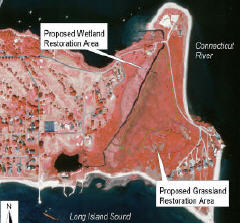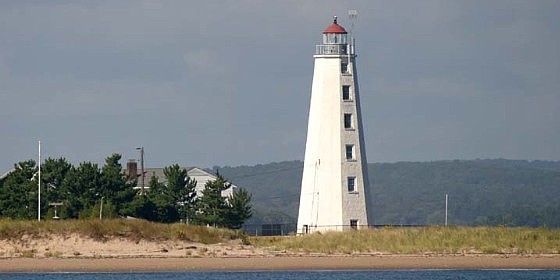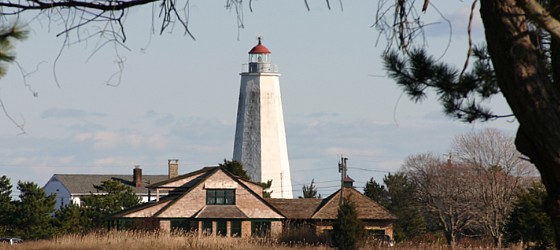|

Lynde Point Marsh Restoration
Borough
of Fenwick, Old Saybrook, Connecticut
Purpose
This project's objective is to restore 10 acres of tidal wetland through the
removal of 60,000 cubic yards of clean, sandy dredge sediments from a former tidal marsh. These sediments will be placed on
adjacent areas where fill is currently up to 6 feet in depth.
Preliminary site assessment involved sediment testing, and results showed the sediments
were clear of contaminants and suitable for re-use on site. Five acres of restored tidal wetland will be low marsh, and three
acres will be high marsh. Two acres of ponds will be constructed. The Connecticut Department of Environmental Protection’s
Wetland Restoration Unit will construct the project. No marsh plantings will be done since experience with previous excavation
projects (e.g. Hammonasset State Park in 1999- 2000; Mumford Cove 1989) has shown that if the proper tidal hydrology is achieved,
marsh plants will naturally re-colonize the site.
The upland areas to receive the additional fill will be graded and stabilized with
sedimentation- and erosion-control measures. A separate grant application is being made to the Natural Resources Conservation
Service for Wildlife Habitat
Incentive Program funds for seeding the area around the restored marsh with warm season native
grasses such as switchgrass (Panicum virgatum) and little bluestem (Schizachyrium scoparium). A total of five acres of coastal
grassland will be planted. DEP and NRCS will monitor the restoration progress.
Background
The Lower Connecticut River is an important feeding and stopover area for migratory
birds, as illustrated by its designation as a Wetland of International Importance. The Connecticut River wetlands have been
identified as regionally important American black duck (Anas rubripes) habitat under the North American Waterfowl Management
Plan.
As shown on historical maps from the late 1800s, this site was formerly a brackish meadow
tidal wetland with a large tidal pond. Sandy dredge sediments from the Connecticut River channel were disposed in the marsh
and pond in the 1940s. The tidal wetlands were filled with the dredge sediment and converted to non-tidal uplands. The invasive
species Phragmites australis now dominates the site. This filled wetland has lost all ecological functions and values normally
provided by a tidal marsh.
The uplands historically consisted of maritime shrubland and forest until the Lynde Point
peninsula was cleared for farmland in the 1800s, and today only a remnant of the habitat remains. Surrounding the proposed
restoration area is 10+ acres of scrub shrubland, lowdensity residential housing and barrier beach.
Benefits
Restoration of the marsh at Lynde Point will provide open water, panne and
brackish meadow habitats that will benefit many species of migratory waterfowl, wading birds, shorebirds and nesting passerines.
Black ducks and other waterfowl will benefit from this project because the open water habitat to be restored will increase
invertebrate and plant food sources and provide additional area for resting and feeding during migration. The proposed restoration
work at Lynde Point will improve habitat for many Federal and State listed species. Populations of small forage fish will
be enhanced, and these baitfish, e.g. mummichog, striped killifish, sheepshead minnow, Atlantic silverside, and inland silverside.
Increased abundance of these forage species will enhance the estuarine food web and result in greater prey resources for numerous
finfish, including the Federally endangered shortnose sturgeon and the state threatened Atlantic sturgeon. Other species that
will be positively impacted by restoration of this important habitat include the bald eagle, the northern harrier, the northern
diamondback terrapin, seaside and saltmarsh sharp-tailed sparrow, and willet and glossy ibis.
 |
 |
LOCATION: Borough of Fenwick,
Town of Old Saybrook, Middlesex County, Connecticut
OWNERSHIP: The Borough of Fenwick holds title
to the land. The Lynde Point Land Trust holds the conservation easement in perpetuity.
PARTNERS: This project is a collaborative effort
between the Lynde Point Land Trust, the Borough of Fenwick, the Connecticut Department of Environmental Protection, the U.S.
Fish and Wildlife Service, Ducks Unlimited, NOAA National Marine Fisheries Service Habitat Restoration Center, Natural Resources
Conservation Service, and the CT CWRP.
FUNDING: The CT CWRP dedicated $17, 930 to the
project. A Coastal Wetlands
Conservation Grant (USFWS) of $80,000 was awarded for this project. Ducks Unlimited Aerial
View of Lynde Point in Old Saybrook, CT. and NOAA are together contributing $30,000. Additional funds and in-kind services
will be provided by CTDEP, NRCS, USFWS, the Borough of Fenwick and the Lynde Point Land Trust. The total project cost is $221,000.
|
|
 |
 |
This 65-foot octagonal granite tower was built in 1838. The Saybrook Breakwater Light was put into service in 1886 and became known as the Outer Light; the Lynde Point Light was thereafter
referred to as the Inner Light. Lynde Point Light was automated in 1978 and remains as an active aid to navigation.
Lynde Point Light House


|

